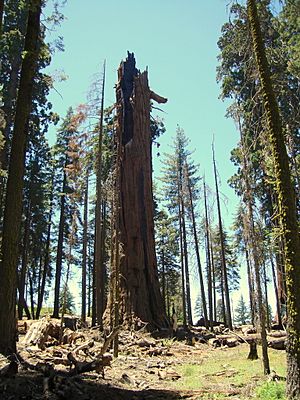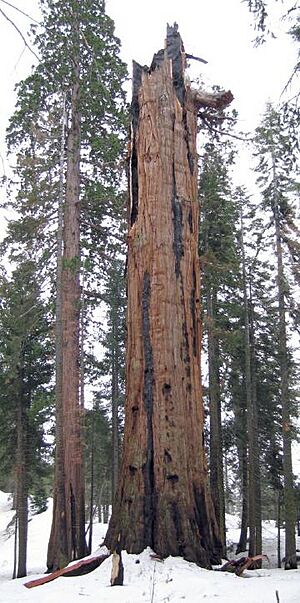Washington (tree) facts for kids
The Washington tree is a giant sequoia, which is one of the biggest trees in the world! You can find it in the Giant Forest Grove in Sequoia National Park, California. This amazing tree is named after George Washington, who was the very first President of the United States. For a long time, until 2005, the Washington tree was the second largest tree on Earth, right after the famous General Sherman tree.
Contents
What Was the Washington Tree Like Before It Was Damaged?
In 1999, scientists studied the Washington tree closely. They found it was about 253.7 feet (77.3 m) tall. That's like a 25-story building! The bottom of its trunk was about 29.9 feet (9.1 m) wide.
Scientists also measured its total volume. This means how much wood was in the tree. It had about 49,550 cubic feet (1,403 m3) of wood. Most of this was in its main trunk. A smaller part was in its 46 biggest branches.
They also found a huge hollow space, called a cavity, inside the tree's trunk. This cavity was about 115 feet (35 m) tall. It was also about 10 feet (3.0 m) wide. You could only get into this cavity through a hole. This hole was very high up, about 190 feet (58 m) above the ground. This discovery was important. It meant that people had thought the tree had more wood than it actually did.
How Did the Washington Tree Get Damaged?
The Washington tree has faced some tough times. In September 2003, a lightning strike hit the tree. This caused a fire in its top part, called the crown. Park officials decided to let the fire burn naturally. The tree lost a big part of its crown because of this fire. Its height was then reduced to about 229 feet (70 m).
What Happened in 2005?
In January 2005, the tree was weakened. A lot of heavy snow piled up on its remaining branches. This heavy snow load caused the tree to partially collapse. It lost more than half of its height. Most of its branches also broke off. A large part of its trunk, including the hollow top section, was lost.
Now, the Washington tree is about 115 feet (35 m) tall. It only has a few living branches near its top.
Is the Washington Tree Still Important?
Even though it's damaged, the Washington tree is still special. It's no longer one of the top ten largest giant sequoias. However, the National Park Service still lists it as the second largest. This is because of their rules. They calculate trees as if they were never damaged.
The good news is that the tree might not be dying. It still has several important branches that are alive. Many other sequoias have survived with less green leaves. The Washington tree could live for many more decades or even centuries!



